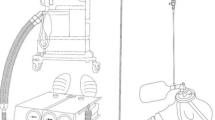Abstract
Objectives: This study examined the effects of various factors that might influence the fraction of oxygen in inspired air (FiO2) in a human and in a model system during nasal positive pressure treatments. Design and Methods: A healthy male volunteer and a mannequin head were each outfitted with a nasal continuous positive air pressure mask and pressure source (BiPAP S, Respironics, Murrysville, PA). Oxygen was added through either a side port in the mask or a port near the machine. Flow and FiO2were measured while varying inspiratory and expiratory pressures. Measurements were repeated with a leak added to the system and using different sites of oxygen administration. Results: In both the human and in the model system, increasing inspiratory pressure, thereby increasing flow, decreased FiO2inside the mask. In the model system, addition of a fixed leak caused an increase in flow and decrease in FiO2at any given level of inspiratory and expiratory pressure. Conclusion: In patients using nasal positive pressure therapy, variables of pressure, leak around the mask, and the site of oxygen delivery determine the inspired oxygen concentration when giving oxygen supplementation.
Similar content being viewed by others
References
Kita H, Ohi M, Chin K, et al. Effects of nasal continuous positive airway pressure therapy on respiratory parameters of upper airway patency in patients with obstructive sleep apnea syndrome. Chest 1998;114:691–696
Naughton MT. Pathophysiology and treatment of Cheyne-Stokes respiration. Thorax 1998;53:514–518
Resta O, Guido P, Picca V, et al. Prescription of nCPAP and nBIPAP in obstructive sleep apnoea syndrome: Italian experience in 105 subjects. A prospective two centre study. Respir Med 1998;92:820–827
Schafer H, Ewig S, Hasper E, Luderitz B. Failure of CPAP therapy in obstructive sleep apnoea syndrome: predictive factors and treatment with bilevel-positive airway pressure. Respir Med 1998;92:208–215
Sampol G, Sagales MT, Roca A, de la Calzada MD, Bofill JM, Morell F. Nasal continuous positive airway pressure with supplemental oxygen in coexistent sleep apnoea-hypopnoea syndrome and severe chronic obstructive pulmonary disease. Eur Respir J 1996;9:111–116
Teschler H, Stampa J, Ragette R, Konietzko N, Berthon-Jones M. Effect of mouth leak on effectiveness of nasal bilevel ventilatory assistance and sleep architecture. Eur Respir J 1999;14:1251–1257
Author information
Authors and Affiliations
Corresponding author
Rights and permissions
About this article
Cite this article
Yoder, E.A., Klann, K. & Strohl, K.P. Inspired Oxygen Concentrations during Positive Pressure Therapy. Sleep Breath 8, 1–5 (2004). https://doi.org/10.1007/s11325-004-0001-y
Issue Date:
DOI: https://doi.org/10.1007/s11325-004-0001-y




